Northern Ecuador, October 2003


Bellavista LodgeVisit the Bellavista website
Bellavista Lodge is a well-known center for birding the upper Tandayapa Valley. We stayed at Bellavista from the night of 13 October 2003 until 17 October, when we returned to Quito.

With a bit of pre-planning a fantastic experience can be had. We had stayed at the lovely, but overpriced ($25 per person per night including breakfast) Bellavista B&B in Quito, where we met our bird- guide, Tyler Hicks (Email Tyler), from Kansas, USA. Tyler has been guiding in Ecuador, using Bellavista as a base for over a month. He is simply superb, and really helped us with identification in our first few days. He also knew many good sites, see below. We also had arranged a driver, Fabian, through Bellavista, for our first two days. This was essential to access some of the more remote sites, such as Yanacocha. Fabian was great, and we felt very safe whilst he was driving. He also spotted some good birds!
Bellavista Lodge is in a wonderful location high in the cloud forest. The weather in October was a little wet, being at the start of the wet season. Mornings were usually warm and sunny, before mist and cloud, with sometimes a little rain, rolling in in the afternoon. The forest around the Lodge contains fabulous birds and we had Toucan Barbets, Spillmann's Tapaculo and Plate-billed Mountain-toucan within the grounds! The staff are all very friendly and helpful, although their treatment by management is sometimes disappointing. We witnessed several "bawling outs" by the owner of some of his staff, which was a little disturbing. We were also quite disappointed by the treatment of some of the young research staff who are doing work here. This work, if done by a professional consultant would cost thousands of dollars to the owner, yet they seem to be having to pay for the privilege, which seems a bit odd, even though the owner will be the one benefitting from the research!

We stayed in the new bamboo house by the gate, which had a fantastic balcony looking straight into beautiful bird-filled forest. The food at the Lodge is first class! Service is also great, adding to a wonderful experience. Meals are served in the Dome, a wonderful construction built on a spur and surrounded by forest. The whole place blends in with the forest much more than any of the other lodges round the area. Despite the treatment of the staff, which really could be improved, the Lodge makes a fantastic base for anybody wishing to bird the area, or for those interested in other aspects of cloud forest wildlife, or just as a stunning place to chill out.

Birding here is fabulous and made easy through the Lodge's well-kept series of trails, and also by the road. The Lodge appears to be right on the border of highland species and lowland species, and consequently gets a huge diversity of birds. Sometimes, these altitiudinal limits are quite dramatic. For example, Cloud Forest Pygmy Owl seems to live on the lower slopes, but suddenly, 50m or so below the Lodge, they vanish and Andean Pymy Owl takes over!
H Trail was our favourite trail and is a fairly easy walk, with some great birding.
Tony's House
A mile or so down the road from Bellavista Lodge is Tony Nunnery's house. When Tony is present, it may be possible to be allowed in to watch the hummers feeding at the dozens of feeders in his backyard. He has recorded 39 species of hummer here! We recorded 20 species in one hour! Please be respectful of Tony and his wife's wishes, this is their home after all! Do not assume you will be allowed in and please make a donation of a minimum of $5 to help towards Tony's sugar bill. This is a fabulous place, please do not abuse Tony and his wife's generosity in sharing their feeders with you.
Yanacocha
We spent the morning of 13/10/03 here on the way into Bellavista. The birding is fantastic, with many species that you will not see at Bellavista, owing to the altitudinal differences.

Birding is fairly easy, being along a trail running along the edge of a mountain. The forest is patchy. Hummingbird feeders are placed at intervals along the main trail and these are filled up depending on the presence of visitors. There is a toilet block at the end of the main trail, which is good. The main trail is linear, and you pretty much walk along it, then back again. There are further trails which begin from the end of the main trail. This is pretty much the only site in the world for Black- breasted Puffleg which is apparently more reliable in February March time. We dipped it. It is mostly seen at the feeders at and just past the toilet block. Sword-billed Hummers are seen on the first few feeders and also on the one by the guard post. Entrance is $5 per person, but please donate more to help the Jocotoco Foundation upkeep this and other reserves.
The Los Bancos Road
14/10/03. This is a road near Mindo, which has a junction with the Quito highway. It can be reached by car from Bellavista in about half an hour. The lowland rainforest has all but disappeared, but patches remain among the cow pastures and agricultural fields. A number of the lowland endemics are still present, such as Choco Toucan, but may not be for much longer. Birding is easy, along the road, which has little traffic. We parked after a mile or so, then walked up and down the road. The local farmers are friendly, although we did not venture off the road. Frustratingly, birds such as the Toucan which have loud calls, can frequently be heard from the road, but it is very difficult to access the patches of forest where they are. The road offers a good mix of lowland forest and open area birds. This was our only site for Moss-backed Tanager.
Septimo Paraiso (Seventh Heaven!!) Lodge, nr Mindo
14/10/03. A new, sprawling place surrounded by cracking forest. This place appears to be new and for $5 you can explore their new trails. We paid the fee, but found that the entrance road, which we could have birded for free was the best spot! They seem to have a number of manakin leks on the property, including a couple of Club-winged and at least one Golden. Once the forest that seems to have been cleared to build this large lodge returns, it will be a superb place.
Mindo, river upstream, near Mariposas
14/10/03. The Mindo area is excellent. Any area with trees or other vegetation is worth a look. We stopped for lunch just up the river from Mindo, and it was full of birds. It is worth coming here for Masked Water-tyrant alone. A cracker!
The Los Colibris Restaurant, Mindo
14/10/03. A lovely spot where you can relax and have a brew, while watching several hummer species on the feeders. It was closed when we arrived, but they opened for us, no problem.
Sachia Tama Reserve, near Mindo
14/10/03. This was a bit of a find. We turned up for half an hour, on a tip off that they had Velvet-purple Coronets. The staff were unbelievably friendly, and allowed us to watch the feeders for free. There is a $5 fee to use the trails. The VPCs were on view immediately. Unfortunately we had no time to bird the area, but if the feeders are anything to go by, it is worth a look.
Mitad Del Mundo, near Quito
17/10/03. Not a birding spot, but worth a quick visit to see the Equator. One or two birds around in the trees too!
Cerro Blanco, near Guayaquil Info about Cerro Blanco
A superb dry forest reserve, just off the main highway which runs west from Guayaquil towards Playa and Salinas.

It cost $20 by taxi from the centre of Guayaquil, but with the help of the reserve staff who generously phoned for a taxi, the return journey was $12! Although it looked closed on arrival, they opened the gates up and let us in. The reserve, part of only 1% of the dry forest on the Ecuadorian coast still left (apparently), is superb. There is a campsite here, a cafe (which was closed) and facilities for children, such as a self-guided nature trail.

After paying $5 each entry at the center, we were free to explore the series of excellent trails in the hills around. Much of the forest has been heavily logged but there are still plenty of birds, including spectacular species such as Great Green Macaw. They are not seen very often but are still here. There are also reputedly Jaguars, Pumas, White-fronted Capuchins and Howler Monkeys, although we only managed a Brocket Deer and a Coati, in our brief visit on 28/10/03. The staff are superbly helpful, very friendly and will sell you a bird list for the site for 50cents. Definitely worth a visit if you plan to visit Guayaquil.
The Birds of Ecuador, Volume 2, (2001), Ridgeley, R.S. and Greenfield, P.J. Helm Fieldguides, was invaluable and the only fieldguide we used. Due to it's bulk, I trimmed the plates from mine and left th text at home. There was a copy lying around at Bellavista Lodge which was used for reference.
The Lonely Planet was also useful and tipped us off about Cerro Blanco. I would recommend, however, buying the most up to date version, as our borrowed 7 year old version was very out of date.
Huge thanks to Tyler Hicks and Fabian without whom much less fun would have been had and far fewer birds would have been seen! Also, thanks to the staff of Bellavista, Sachia Tama and especially Cerro Blanco for being welcoming, friendly and delightful.
Thanks to my wife, Vicky, for inspiring me.
Neotropic Cormorant, Phalacrocorax brasilianus One seen on a small river near Cerro Blanco.
Great Egret, Ardea alba A single seen in flight over the Los Colibris Restaurant, Mindo.
Yellow-crowned Night-heron, Nyctanassa violacea An adult on the river at Guayaquil on the afternoon of 29/10/03.
Torrent Duck, Merganetta armata A female on the Tandayapa River, just up the valley from Tandayapa on 13/10/03.
Turkey Vulture, Cathartes aura Common.
Black Vulture, Coragyps atratus Several seen in the Mindo area and around Guayaquil.
Great Black Hawk, Buteogallus urubitinga One over Cerro Blanco.
Barred Hawk, Leucopternis princeps One soaring mid-morning, near Tony Nunnery's house on 16/10/03.
Variable Hawk, Buteo polyosoma A very-Rough-legged-buzzard/hawk-type individual hovering around the grasslands just below Yanacocha.
Roadside Hawk, Buteo magnirostris Common at Los Bancos and in the Mindo area.
Short-tailed Hawk, Buteo brachyurus One soaring with black vultures along the Quito highway, near the Los Bancos road on the 14/10/03. One soaring mid-morning, near Tony Nunnery's house on 16/10/03.
Gray Hawk, Buteo nitidus One on the Los Bancos road.
Black-and-Chestnut Eagle, Oroaetus isidori A huge adult watched soaring between Tony Nunnery's house and Bellavista Lodge late morning on 16/10/03. This bird has been seen regularly, recently. The very broad wings were held very exaggeratedly upswept.

Black Hawk-eagle, Spizaetus tyrannus A single calling adult seen circling above Bellavista Lodge, at 07.45 on 15/10/03.
Bi-colored Hawk, Accipter ventralis A single seen perched among foliage in a tree top along the Los Bancos Road.
American Kestrel, Falco sparverius Common. Mostly of the subspecies aequatoralis.
Sickle-winged Guan, Chamaeptes goudotii Singles seen most days in the Bellavista area. An obliging individual roosts in a large tree overhanging the H Trail just past the compost heap most nights.
Andean Guan, Penelope montagnii One at Yanacocha.
(White-throated Crake, Laterallus albigularis) A single calling from riverside vegetation on the outskirts of Mindo.
Rufous-necked Wood-rail, Aramides axillaries Two seen feeding under mangroves at Parque Historico, Guayaquil.
Moorhen, Gallinula chloropus Seen somewhere!
Spotted Sandpiper, Actitis macularia Singles on the rivers at Mindo, Guayaquil and at Parque Historico, Guayaquil.
Band-tailed Pigeon, Columba fasciata Small numbers seen most days in the Bellavista area.
Plumbeous Pigeon, Columba plumbea A single seen in a fruiting tree half way along H trail at Bellavista on 14/10/03 with a pair there next day.
(White-throated Quail-dove, Geotrygon frenata) The bird which regularly frequents the compost heap at the top of H trail failed to show up, although he was heard a couple of times.
Eared Dove, Zenaida auriculata Common, especially in urban areas, such as Quito.
Ecuadorian Ground-dove, Columbina buckleyi Common at Cerro Blanco.
Pallid Dove, Leptotila pallida A couple of individuals seen during the week in the Bellavista area.
White-tipped Dove, Leptotila verreauxi Individuals of the subspecies decolor were common in most areas. One was regularly seen at dawn near the compost heap on H trail, which may have been the reason why the Quail-dove was not around so much.
Pacific Parrotlet, Forpus coelestis Very conspicuous due to loud calling at Cerro Blanco.
Barred Parakeet, Bolborhynchus lineola Very common at Bellavista. This species is very difficult to see well! Every day we would see many flocks flying over at high level calling, but we could never find any perched.
Gray-cheeked Parakeet, Brotogeris pyrrhopterus Common at Cerro Blanco, mixing with Pacific Parrotlets and equally as noisy!
Red-billed Parrot, Pionus sordidus Eight seen along the Nono-Mindo road on 14/10/03.
White-capped Parrot, Pionus seniloides A pair seen along H trail at Bellavista on 14 and 15/10/03.
Bronze-winged Parrot, Pionus chalcopterus Common at Los Bancos road.
Squirrel Cuckoo, Piaya cayana This huge, gangly cuckoo was seen regularly around Bellavista. A single was seen at Cerro Blanco.
Smooth-billed Ani, Crotophaga ani Common around farmland, notably along the Los Bancos road and at Parque Historico, Guayaquil.
(Andean Pygmy-owl, Glaucidium jardinii) Calling frequently throughout the morning at Yanacocha, possibly due to the presence of a birding group from the Tandayapa Bird Lodge who persistently used a recording of this species to try and lure-out other birds. This behaviour caused obvious consternation among the local owl population and was also very confusing and annoying for all other birders present and should not be encouraged!
Common Potoo, Nyctibius griseus One seen well near the entrance to Bellavista Lodge on 13/10/03 at 7pm, with two on the road above the Lodge on 16/10/03.
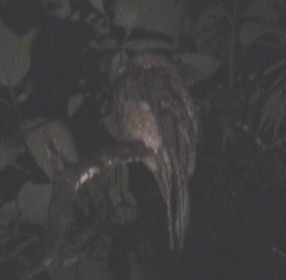
Swallow-tailed Nightjar, Uropsalis segmentataThe female seen well a number of times at her roost site on a piece of bamboo, on the road below Bellvista Lodge. This individual or perhaps another was seen in flight at dawn on 16/10/03.
Lyre-tailed Nightjar, Uropsalis lyraA calling individual was seen briefly in flight at dawn on 16/10/03.
Rufous-bellied Nighthawk, Lurocalis rufiventrisSeen frequently around Bellavista at dawn and dusk.
Band-winged Nightjar, Caprimulgus longirostris At Bellavista, one landed on the H Trail right next to us at dusk on 14/10/03 with another seen near the Lodge entrance at dawn on 16/10/03.
White-collared Swift, Streptoprocne zonarisThis spectacular, powerful swift was common below Bellavista and along the Los Bancos Road.
Chestnut-collared Swift, Cypseloides rutilusCommon around Tony Nunnery's house on 16/10/03. The chestnut was quite difficult to see unless the underside of the swift caught the sun at fairly close range.
Spot-fronted Swift, Cypseloides cherreiThanks to a tip-off from Tony Nunnery, we saw several individuals of this enigmatic species among flocks of the previous two species in the valley around his house on 16/10/03. Tony pointed out the spots appearing like headlights when the birds approached head-on!
Band-rumped Swift, Chaetura spinicaudaSmall numbers seen over the Los Bancos Road.
Gray-rumped Swift, Chaetura cineriventrisTwo of the subspecies occidentalis seen along the Los Bancos Road.
White-tipped Swift, Aeronautes montivagusSeveral among swift flock around Tony's house on 16/10/03.
White-whiskered Hermit, Phaethornis yaruquiOne or two individuals seen at feeders at Los Colibris Restaurant.
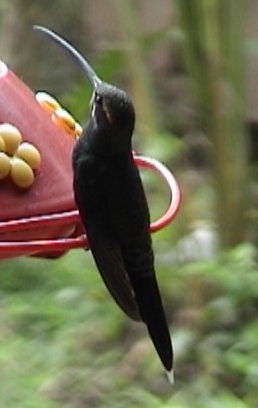
Little Hermit, Phaethornis longuemareusTwo seen at Parque Historico, Guayaquil.
Long-tailed Hermit, Phaethornis superciliosusSingle individual seen well at Cerro Blanco. Both this and the previous species are not in the new Ecuador fieldguide!
Tawny-bellied Hermit, Phaethornis syrmatophorusSeen occasionally around Bellavista, including an individual collecting spiders webs, presumably as nesting material on 16/10/03. Also seen at Septimo Paraiso.
Wedge-billed Hummingbird, Schistes geoffoyiA male seen well at Septimo Paraiso, along the entrance road.
Purple-bibbed Whitetip, Urosticte benjaminiA male seen at the Sachia Tamia reserve on the feeders.
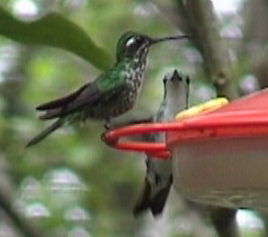
Speckled Hummingbird, Adelomyia melanogenysCommon in the Bellavista area
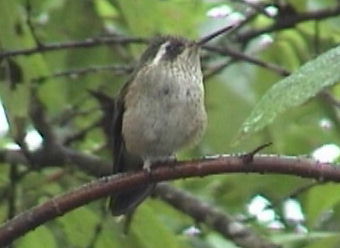
Booted Racquet-tail, Ocreatus underwoodiiSmall numbers seen at Tony Nunnery's house, Sachia Tama and one female regularly at the feeders at Bellavista Lodge. All males were of the white-booted subspecies, melanantherus. This female (below) shares a feeder with an Andean Emerald.
Purple-throated Woodstar, Calliphlox mitchelliCommon around the Bellavista area. Known to locals as "Bunga", which is apparently a reference to the birds' bee-like appearance.
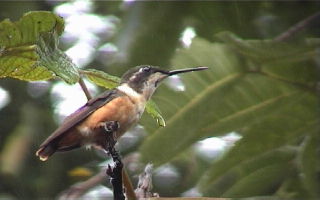
White-bellied Woodstar, Chaetocercus mulsantA couple of individuals seen at Los Colibris Restaurant, Mindo.
Purple-crowned Fairy, Heliothryx barrotiA single male seen along the Los Bancos Road.
Green Violetear, Colibri thalassinusCommon from Tony Nunnery's house downwards to Mindo.
Sparkling Violetear, Common at Tony Nunnery's house, Sachia Tama and one individual seen at Mitad Del Mundo.
Fawn-breasted Brilliant, Heliodoxa leadbeateriCommon around the feeders at Bellavista Lodge.
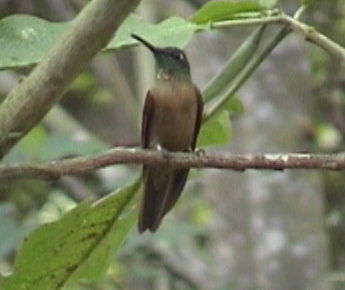
Green-crowned Brilliant, Heliodoxa jaculaSingle immature male at Los Colibris and four individuals at Sachia Tama.
Empress Brilliant, Heliodoxa imperatixThis large hummer was seen at Los Colibris, Sachia Tama and Tony Nunnery's house.
Rufous-tailed Hummingbird, Amazilia tzacatl Abundant at Los Colibris and several seen at Cerro Blanco.

Amazilia Hummingbird, Amazilia amaziliaOne seen at Cerro Blanco.
Andean Emerald, Amazilia franciaeFairly common around the Bellavista area.

Green-crowned Woodnymph, Thalurania fannyi2A couple were seen at Los Colibris Restaurant.
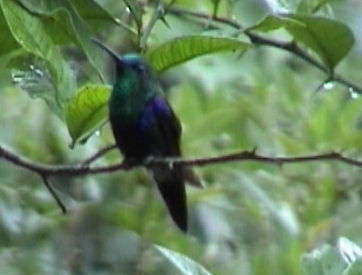
Western Emerald, Chlorostilbon melanorhynchusThis glittering gem was seen at the feeders in Tony Nunnery's garden.
White-tailed Hillstar, Urochroa bougueriA single male was present intermittently at Tony Nunnery's feeders.
Great Sapphirewing, Pterophanes cyanopterusThis superb species was common at Yanacocha.

Brown Inca, Coeligena wilsoniCommon at Sachia Tama, with individuals seen occasionally on the lower parts of Bellavista. Only one was seen at the feeders at the Lodge.
Collared Inca, Coeligena torquataPresent in small numbers at all feeders visited, including a single at Yanacocha, which is higher than the usual altitudinal range for this species.

Buff-winged Starfrontlet, Coeligena lutetiaeThe most common hummer at the feeders at Yanacocha.


Black-tailed Trainbearer, Lesbia victoriaeSmall numbers seen in Quito, with a single seen at Mitad Del Mundo.
Green-tailed Trainbearer, Lesbia nunaA pair seen at Tony Nunnery's house.
Violet-tailed Sylph, Aglaiocercus coelestisSeen in the Mindo and Bellavista areas in small numbers.
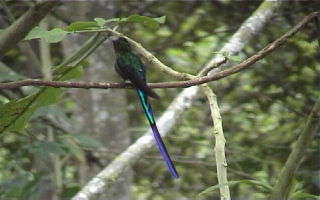
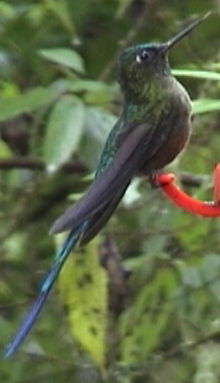
Buff-tailed Coronet, Boissonneaua flavescensThe commonest hummer at the feeders at Bellavista Lodge, with small numbers elsewhere.

Velvet-purple Coronet, Boissonneaua jardiniAn absolutely stonking male seen at Sachia Tama. This is currently the most consistent site for this species in the Mindo area with up to three individuals present.
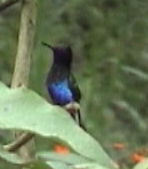
Mountain Velvetbreast, Lafresnaya lafresnayiA female seen at Yanacocha.
Sapphire-vented Puffleg, Eriocnemis lucianiCommon around the feeders at Yanacocha.


Golden-breasted Puffleg, Eriocnemis mosqueraSmall numbers around the feeders at Yanacocha.
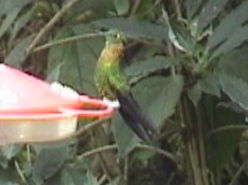
Tyrian Metaltail, Metallura tyrianthinaCommon at Yanacocha. Males were engaging in lots of vicious combat!

Rainbow-bearded Thornbill, Chalcostigma stanleyiOne was seen at a feeder at Yanacocha, which is quite unusual, as they apparently don't visit feeders too often.
Gorgeted Sunangel, Heliangelus strophianusCommon in the Bellavista area.

Black-tailed Trogon, Trogon melanurusSeveral seen at Cerro Blanco.
Masked Trogon, Trogon personatusIndividuals of the subspecies assimilis commonly seen and heard in the Bellavista area. Female (left) and male below.
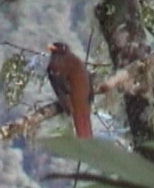
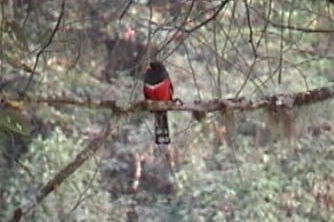
Guayaquil Woodpecker, Campephilus guayaquilensisA female was seen well at the Los Bancos Road.
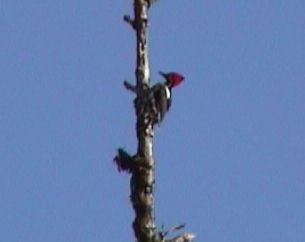
(Powerful Woodpecker, Campiphilus pollens)Heard frequently at Bellavista, but not seen.
Golden-headed Quetzal, Pharomachrus auricepsUp to three individuals seen most days at Bellavista. Also seen at Septimo Paraiso and on the road just above Tandayapa. A pair was regularly seen along H trail at Bellavista.
Blue-crowned Motmot, Momotus momotaTwo seen at Cerro Blanco. Both were around the buildings.
Turquoise Jay, Cyanolyca turcosaVery common and noisy in the Bellavista area. Usually seen in small flocks of up to ten.
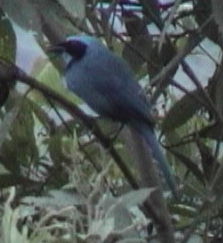
Beautiful Jay, Cyanolyca pulchraHeard occasionally around Bellavista, the only sightings being of three, late afternoon in trees along the road below the Lodge. This species is much more elusive than Turquoise Jay and usually remains higher in the trees, whereas the latter species often descends to ground level.
White-tailed Jay, Cyanocorax mystacalisVicky saw one individual at Cerro Blanco.
Toucan Barbet, Semnornis ramphastinusOne of the Bellavista specialities, this species was commonly heard duetting around the Bellavista area. Two individuals seen, both within trees at the Lodge, the first of which was from our balcony!
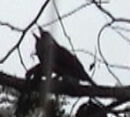
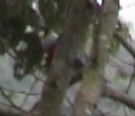
Barred Puffbird, Nystalus radiatusOne seen clobbering a lizard on a branch along the Los Bancos Road.
(Crimson-rumped Toucanet, Aulacorhynchus haematopygus)Seen very briefly from the car, on the road between Tandayapa and Bellavista. A Golden-headed Quetzal had flown across the road, so we stopped to have a look. Fabian then shouted toucan, and we turned just in time to see a toucan-shaped sillhouette disappearing into the forest. In looking for this bird, a female Andean-cock-of-the-rock flew across in front of us, hotly pursued by three males. They landed giving great views. A pretty mad couple of minutes birding!
Pale-mandibled Aracari, Pteroglossus erythropygiusA pair seen well on the entrance road to Septimo Paraiso.
Plate-billed Mountain-toucan, Andigena laminirostrisAnother Bellavista special, at least two seen every day around the trails. Our first were a courting pair which interrupted our first lunch at the Lodge, by landing in a tree right next to the dome. The male offered a large berry to the female, who, unimpressed took no interest. The male ate it himself.
(Choco Toucan, Ramphastos brevis)Heard at Los Bancos Road. Frustratingly, we could not view the trees where they were calling from. To add insult to injury, Fabian saw a pair fly over as he waited for us by the car!
Crimson-mantled Woodpecker, Piculus rivoliiSeen regularly around Bellavista and a pair at Mindo by the river.
Golden-olive Woodpecker, Piculus rubiginosusThree rubripileus individuals seen at Cerro Blanco, with a pair at Parque Historico, Guayaquil.
Ecuadorian Piculet, Picumnus sclateriA single seen climbing about on twigs at Cerro Blanco.
Tyrannine Woodcreeper, Dendrocincla tyrannina Common at Bellavista.
Wedge-billed Woodcreeper, Glyphorhynchus spirurus One at the Los Bancos Road.
Strong-billed Woodcreeper, Xiphocolaptes promeropirhynchus This large woodcreeper was seen most days at Bellavista, usually with mixed feeding flocks.
Spotted Woodcreeper, Xiphorhynchus erythropygius One at Septimo Paraiso, on the entrance track.
Streak-headed Woodcreeper, Lepidocolaptes souleyetii Several at Cerro Blanco.
Montane Woodcreeper, Lepidocolaptes lacrymiger Seen singly or occasionally in pairs with mixed species flocks in forest around the Bellavista area.
Azara's Spinetail, Synallaxis azarae Commonly heard and occasionally seen at Bellavista.
Rufous Spinetail, Synallaxis unirufa Heard occasionally in the Bellavista area. One seen on 13/10/03.
Slaty Spinetail, Synallaxis brachyura A couple were seen at the Los Bancos Road.
Red-faced Spinetail, Cranioleuca erythrops Seen at Septimo Paraiso.
Pearled Treerunner, Margaarornis squamiger One seen at Bellavista on 13/10/03.
Lineated Foliage-gleaner, Syndactyla subalaris Commonly seen in pairs around Bellavista, including trees by the Lodge.
Buff-fronted Foliage-gleaner, Philydor rufus One seen near the river upstream of Mindo.
Pacific Hornero, Furnarius cinnamomeus Single at the Los Bancos Road. Common at Cerro Blanco, feeding in pairs on the tracks and in leaf litter.

Streaked Tuftedcheek, Pseuocolaptes boissonneautii Seen singly or in pairs most days at Bellavista.
Striped Treehunter, Thripadectes holostictus One with mixed feeding flock at Bellavista on 13/10/03.
Streak-capped Treehunter, Thripadectes virgaticeps One at Septimo Paraiso.
Collared Antshrike, Sakesphorus bernardi Confiding and obvious at Cerro Blanco, with several seen.
Plain Antvireo Dysithamnus mentalis A small flock seen on wooded slopes of Cerro Blanco. This flock contained the Pacific Royal Flycatcher.
(Rufous-breasted Antthrush, Formicarius rufipectus) Seen badly but heard frequently at Septimo Paraiso.
(Undulated Antpitta, Grallaria squamigera) Heard at Yanacocha.
(Giant Antpitta, Grallaria gigantea) Heard frequently at Bellavista, but remained invisible, despite having been described as an American football on legs!
(Chestnut-crowned Antpitta, Grallaria ruficapilla) Another frequently heard antpitta at Bellavista, which remained hidden. Dawn and dusk are apparently best to see this skulker.
(Yellow-breasted Antpitta, Grallaria flavotincta) This species was heard occasionally from the lower slopes below Bellavista. There seems to be a very sharp altitudinal limit for this and the previous two species. Chestnut-crowned seems to be common down to just below the Bellavista Lodge, where it is replaces by Yellow-breasted. Both, however, are very skulking and hard to see.
(Ocellated Tapaculo, Acropternis orthonyx As with the antpittas, this species is heard regularly, but is very difficult to see. Two very close calling pairs were above the lodge on the roadside. One pair was 100m before the oil pipeline, with the other being 150m uphill from the campsite. Both pairs were incredibly close, indeed we heard the birds' footsteps in the litter, but remained out of sight!
Spillmann's Tapaculo, Scytalopus spillmanni Another little skulker, but seen well every day around Bellavista. This species is like a little black mouse and creeps about on the ground. One seems to hide in the log pile under the tarpaulin, just past the compost heap on H Trail.
Marble-faced Bristle-tyrant, Pogonotriccus opthalmicus Singles seen at Mindo and Bellavista.
Black-capped Tyrannulet, Phyllomyias nigrocapillus One seen at Bellavista, below the Lodge on 13/10/03.
Mouse-colored Tyrannulet, Phaeomyias murina Single seen at Cerro Blanco.
Southern Beardless-tyrannulet, Camptostoma obsoletum Fairly common at Cerro Blanco.
Streak-necked Flycatcher, Mionectes stiaticollis Two seen at the Los Bancos Road.
Olive-striped Flycatcher, Mionectes olivaceus One at the Los Bancos Road.
Golden-faced Tyrannulet, Zimmerius chrysops Single at the Los Bancos Road.
White-crested Elaenia, Elaenia albiceps A single bird observed on the old Nono road above Bellavista, on 19/10/03, with another probable on the H Trail.
Sierran Elaenia, Elaenia pallatangae Common in the Bellavista area.
Yellow-bellied Elaenia, Elaenia flavogaster A single seen at Cerro Blanco.
Common Tody-flycatcher, Todirostrum cinereum Single seen at Los Bancos Road. A pair seen near the cafe at Cerro Blanco.
Tawny-crowned Pygmy-tyrant, Euscarthmus meloryphus Common at Cerro Blanco.
Rufous-headed Pygmy-tyrant, Pseudotriccus ruficeps Single seen at Yanacocha, followed by a pair on H Trail on 15/10/03. A very distinct "crackling" call likened to electricity led to the discovery of all three birds.
Torrent Tyrannulet, Serpophaga cinerea Seen on the river at Mindo.
Cinnamon Flycatcher, Pyrrhomyias cinnamomoea Fairly common in the Bellavista area.
Flavescent Flycatcher, Myiophobus flavicans One above Bellavista on the 17/10/03.
White-throated Tyrannulet, Mecocerculus leucophrys Two seen at Yanacocha.
White-tailed Tyrannulet, Mecocerculus poecilocerus Common in the Bellavista area.
White-banded Tyrannulet, Mecocerculus stictopterus A single seen at Yanacocha.
Rufous-winged Tyrannulet, Mecocerculus calopterus Two seen on the road between Tandayapa and Bellavista.
Western Wood-pewee, Contopus sordidulus Occasionally seen in the Bellavista area.
Smoke-colored Pewee, Contopus fumigatus A couple seen most days at Bellavista.
Pacific Royal Flycatcher, Onychorhynchus coronatus Cracking views of a solitary bird associating with a Plain Antvireo flock in the understorey on the lower slopes at Cerro Blanco.
Bran-colored Flycatcher, Myiophobus fasciatus Three at the Los Bancos Road.
Smoky Bush-tyrant, Myiotheretes fumigatus A single was seen at Yanacocha.
Vermillion Flycatcher, Pyrocephalus rubinus A single male seen near the nursery at Cerro Blanco.
Brown-backed Chat-tyrant, Ochthoeca fumicolor Single observed on scrubby hillside at Yanacocha.
Black Pheobe, Sayornis nigricans Single flitting about on the rocks in the river above Mindo.
Masked Water-tyrant, Fluvicola nengeta An absolute cracker of a bird, looking like a pale Black-eared Wheatear, zipping about on the rocks in the fast-flowing river just above Mindo town.
Tropical Kingbird, Tyrannus melancholicus Common, especially in the lowlands, where regularly seen on wires. Seen in Guayquil city centre too.
Golden-crowned Flycatcher, Myiodynastes chrysocephalus A pair feeding fledged young were around Bellavista Lodge most days.
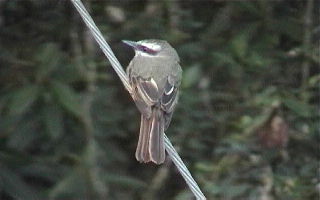
Boat-billed Flycatcher, Megarynchus pitangua A single was observed near the campsite at Cerro Blanco. Single observed near the campsite at Cerro Blanco.
Rusty-margined Flycatcher, Myiozetetes cayanensis A single individual was in bushes by the river upstream from Mindo.
Black and White Becard, Pachyramphus albogriseus One seen at Bellavista Lodge on 17/10/03 in a mixed flock.
Red-crested Cotinga, Ampelion rubocristatus A single individual was watched perched atop a bush in a wooded valley just below Yanacocha.
Green and Black Fruiteater, Pipreola rieferii Common around Bellavista, but although seen frequently, the high-pitched call was even more common.
Andean Cock-of-the-rock, Rupicola peruviana Three males and a female were a fantastic and lucky surprise on our journey up to Bellavista, just outside Tandayapa village during the afternoon. These birds casually lekked due to the presence of the female and allowed close views. A male was subsequently seen in a similar place, perched next to the road in a bare tree, on the return journey to Quito. All individuals of the stonkingly bright orange-red sanguinolenta subspecies.
Club-winged Manakin, Machaeropterus deliciosus One calling male gave prolonged, close views at Septimo Paraiso. At least two leks containing calling birds were found, but thick undergrowth prevented further sightings.
(Golden-winged Manakin, Masius chrysopterus) Lekking birds were calling from a steep, wooded hillside above the entrance track at Septimo Paraiso, but access was impossible.
Blue and White Swallow, Notiochelidon cyanoleuca Common, especially in the lower Tandayapa Valley.
Southern Rough-winged Swallow, Stelgidopteryx ruficollis Common in lowland areas, such as the lower Tandayapa Valley. Often mixing with the former species.
Rufous Wren, Cinnycerthia unirufa This big bright rufous wren was seen well at Yanacocha.
Gray-breasted Wood-wren, Henicorhina leucophrys Very common, but heard more frequently than seen, in the Bellavista area.
Fasciated Wren, Campylorhynchus fasciatus Three or four seen at Cerro Blanco, with a pair feeding and showing well near the cafe.
Speckle-breasted Wren, Thryothorus sclateri Common at Cerro Blanco.
House Wren Troglodytes aedon Common at most sites.
Tropical Gnatcatcher, Polioptila plumbea Very common at Cerro Blanco. All of white-faced bilineata subspecies.
Rufous-browed Peppershrike, Cyclarhis gujanensis Two or three seen at Cerro Blanco.
White-capped Dipper, Cinclus leucocephalus Three on the river between Tandayapa and Bellavista.
Red-eyed Vireo, Vireo olivaceus Very common, especially around the river near Mindo, but also in the Bellavista area.
Brown-capped Vireo, Vireo leucophrys Occasional individuals seen at most sites, usually among flocks of Red-eyed Vireos.
(Andean Solitaire, Myadestes ralloides) Very commonly heard in the Bellavista area, but very elusive and not seen conclusively.
Glossy-black Thrush, Turdus serranus Heard frequently in the Bellavista area, with a pair being seen feeding on the Nono road on 15/10/03.
Ecuadorian Thrush, Turdus maculirostris Two seen at Cerro Blanco, including one feeding on the dirt road by the nursery.
Great Thrush, Turdus fuscater Very common, especially at Yanacocha.

Blackburnian Warbler, Dendroica fusca Common in the Bellavista area, where often in small numbers in mixed species flocks.
Tropical Parula, Parula pitiayumi Common in all wooded areas.
Black-crested Warbler, Basileuterus nigrocristatus Common in roadside bushes and mixed species flocks in the Bellavista area.
Gray and Gold Warbler, Basileuterus fraseri Common at Cerro Blanco, feeding low down, often on the ground.
Three-striped Warbler, Basileuterus tristriatus Small numbers seen most days at Bellavista.
Russet-crowned Warbler, Basileuterus coronatus Common in the Bellavista-Mindo areas.
Bananaquit, Coeraba flaveola Very common at Cerro Blanco.
Cinerous Conebill, Conirostrum cinereum Several at Yanacocha.
Capped Conebill, Conirostrum albifrons A pair at Bellavista on 13/10/03, with a single on the 16/10/03.
Blue-backed Conebill, Conirostrum sitticolor One at Yanacocha.
Glossy Flowerpiercer, Diglossa lafresnayii Many seen at Yanacocha, where it replaced Black Flowerpiercer in the higher areas.
Black Flowerpiercer, Diglossa humeralis Three seen along the road up to Yanacocha from Quito.
White-sided Flowerpiercer, Diglossa albilatera Common in the Bellavista area.
Masked Flowerpiercer, Diglossopis Four at Yanacocha.
Orange-bellied Euphonia, Euphonia xanthogaster A couple seen at the Los Bancos Road.
Orange-crowned Euphonia, Euphonia saturata Single seen at Cerro Blanco near the campsite.
Thick-billed Euphonia, Euphonia laniirostris Common at the Los Bancos Road.
Swallow Tanager, Tersina viridis A pair seen at the Los Bancos Road.
Blue-necked Tanager, Tangara cyanicollis
Fawn-breasted Tanager, Pipraeidea melanonota One seen on the Los Bancos Road. Common in the Bellavista area.
Golden Tanager, Tangara arthus Common along the Los Bancos Road. One of the most beautiful and common tanagers around Bellavista.
Silver-throated Tanager, Tangara icterocephala One on the Los Bancos Road.
Beryl-spangled Tanager, Tangara nigroviridis Common in the Bellavista area, but usually keeping to the canopy, so views not often good.
Rufous-throated Tanager, Tangara rufigula Two on the Los Bancos Road.
Bay-headed Tanager, Tanagara gyrola This beauty was seen by Vicky and Tyler only, by the river at Mindo.
Golden-naped Tanager, Tangara ruficervix Singles seen at Bellavista on a couple of days.
Golden-crowned Tanager, Iridosornis rufivertex Two at Yanacocha.
Scarlet-bellied Mountain-tanager, Anisognathus igniventris One of the commonest tanagers at Yanacocha. Unusually a small flock were seen above Bellavista, near the Old Nono Road, which is pretty low for this species.

Black-chested Mountain-tanager, Buthraupis eximia Three at Yanacocha.
Blue-winged Mountain-tanager, Anisognathus somptuosus Very common in the Bellavista area, with a pair feeding fledged young on H Trail on 17/10/03.
Moss-backed Tanager, Bangsia edwardsi An individual of this rare species was seen well a couple of times at the Los
Grass-green Tanager, Chlorornis riefferii Common at Bellavista, one bird above the Lodge suffering from a large tick on the face.
Blue-gray Tanager, Thraupis episcopus Very common in the Guayaquil area and in all lowland sites visited.
Palm Tanager, Thraupis palmarum Common at the Los Bancos Road.
Blue-capped Tanager, Thraupis cyanocephala Fairly common around Bellavista.
Lemon-rumped Tanager, Ramphocelus icteronotus Very common at the Los Bancos Road and in the Mindo area.
Rufous-chested Tanager, Thylpopsis ornata One at Bellavista on 15/10/03.
Yellow-throated Bush-tanager, Chlorospingus flavigularis A single was seen on the Los Bancos Road.
Dusky Bush-tanager, Chlorospingus semifuscus One near Bellavista on 13/10/03, with another along the H Trail on 15/10/03. Very common above the Lodge on 17/10/03.
Superciliaried Hemispingus, Hemispingus superciliaris One at Yanacocha.
Western Hemispingus, Hemispingus ochraceus One on H trail, Bellavista on 14/10/03.
Buff-throated Saltator, Saltator maximus A pair seen at the river above Mindo.
Streaked Saltator, Saltator striatipectus Common at Cerro Blanco.
Southern Yellow Grosbeak, Pheucticus chrysogaster Common in the Bellavista area. Also seen at Cerro Blanco and Yanacocha.
Blue-black Grassquit, Volatinia jacarina Singing male and a couple of females seen in pastures along Los Bancos Road.
Variable Seedeater, Sporophila corvina Common along the Los Bancos Road. Seen at Septimo Paraiso.
Yellow-bellied Seedeater, Sporophila nigricollis Small numbers on the road into Bellavista from Tandayapa and along the Los Bancos Road.
Plain-colored Seedeater, Catamenia inornata One at Yanacocha.
White-winged Brush-finch, Atlapetes leucopterus Singles seen along the road below Bellavista Lodge on 16-17/10/03, with two on the 15/10/03.
Tricolored Brush-finch, Atlapetes tricolor One in the Lower Tandayapa Valley on the drive to Bellavista.
Chestnut-capped Brush-finch, Buarremon brunneinucha This is meant to be quite a skulking species, but we had a lot of good views at Bellavista, mainly on the H Trail, early morning or at dusk. Three together on 15/10/03 was the highest count. They seem to feed on the trail out in the open and are confiding.
Crimson-breasted Finch,Rhodospingus cruentus Several at Cerro Blanco.
Rufous-collared Sparrow, Zonotrichia capensis One of the commonest birds we encountered. Present at all altitudes and in all habitats, though we never tired of seeing this handsome species.
Black-capped Sparrow,Arremon abeillei One seen feeding along the trail at Cerro Blanco.
Scrub Blackbird, Dives warszewiczi Very common at Cerro Blanco.
Russet-backed Oropendola, Psarocolius angustifrons Singles seen most days at Bellavista. One seen in flight at Los Colibris Restaurant, Mindo.
Yellow-tailed Oriole, Icterus mesomelas Common at Cerro Blanco, often in groups.
White-edged Oriole, Icterus graceannae Two seen at Cerro Blanco, in groups of Yellow-tailed Oriole. Very distinctive but almost overlooked!
Yellow-billed Cacique, Ambylycercus holosericeus A pair seen at Cerro Blanco.
Shiny Cowbird, Molothrus boneriensis Very common around Mindo.
Great-tailed Grackle,Quiscalus mexicanus Common along the Malecon and at Parque Historico, both in Guayaquil.
all material on this website is copyright Jono Leadley 2004